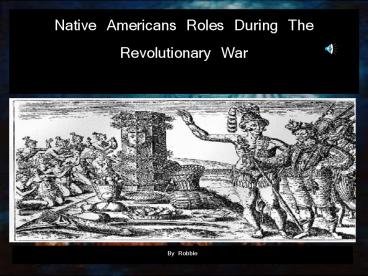Native Americans Roles During The Revolutionary War PowerPoint PPT Presentation
1 / 12
Title: Native Americans Roles During The Revolutionary War
1
Native Americans Roles During The Revolutionary
War
By Robbie
2
Tribes Who Helped Out During the War
Oneida Chief Oskanondonha Location Present Day
New York State Iroauois Chief Cornplanter
Location Present Day Illinois
3
Oneida
The Oneida people are members of the Six Nations
of the Iroquois or Hodashone. Even before
European invasion of the North American
continent, these people were living in distinct
territories in the northeastern section of the
country. The Oneida territory was in what is now
New York State, with the Mohawk Nation east of
this land and the Onondaga, Cayuga, and Seneca
territories to the west.
4
Chief Oskanondonha
Oskanondonha was a chief warrior of the Wolf
clan. Although he was a great warrior in his
younger days, nothing of this career was
recorded. He first appears in the written records
in the context of war warning the British of
danger at Fort Stanwix in 1758 leading a war
party (probably composed of warriors from the
Wolf clan) against the French at Montreal in 1760
(Johnson Papers 1083,183). In 1770, he was named
as the "best and properest" leader of the
principal Oneida village -- Oneida Castle
(Johnson Papers 12836-7).
5
Iroquois
The original homeland of the Iroquois was in
upstate New York between the Adirondack Mountains
and Niagara Falls. Through conquest and
migration, they gained control of most of the
northeastern United States and eastern Canada. At
its maximum in 1680, their empire extended west
from the north shore of Chesapeake Bay through
Kentucky to the junction of the Ohio and
Mississippi Rivers then north following the
Illinois River to the south end of Lake Michigan
east across all of lower Michigan, southern
Ontario and adjacent parts of southwestern
Quebec and finally south through northern New
England west of the Connecticut River through the
Hudson and upper Delaware Valleys across
Pennsylvania back to the Chesapeake. With two
exceptions - the Mingo occupation of the upper
Ohio Valley and the Caughnawaga migration to the
upper St. Lawrence - the Iroquois did not, for
the most part, physically occupy this vast area
but remained in their upstate New York villages.
6
CornPlanter
CornPlanter
Cornplanter (Kaiiontwa'kon, "By What One Plants")
was born at Canawagus on the Genesee River in
present-day New York State around 1740. His
father was an Albany trader named John Abeel or
O'Bail, and Cornplanter was known to the English
as John O'Bail or Captain O'Bail. His half
brother Handsome Lake was an Iroquois Confederacy
chief, as was a nephew who was known as
Blacksnake or Governor Blacksnake.During the
American Revolution, Cornplanter was chosen at a
gathering of warriors (along with the respected
Seneca war chief Old Smoke) to lead the Iroquois
warriors in support of the British.
7
Hero's of the American Revolution
The Oneida Nation chose to support the colonists'
fight for liberty during the Revolutionary War.
Oneidas contributed greatly to the American
victory and sacrificed much for their stand.
Their part in the war is still neglected by
historians. Oskanondonha played a key role in the
Oneida decision to back the American cause. This
was common knowledge in his time. As noted in his
obituary "In the Revolutionary War, his
influence induced the Oneidas to take up arms in
favor of the Americans."
8
Cherokee Tribes
The Cherokee lived mainly in what is now
Tennessee and Georgia. Like the Iroquois, the
Cherokee depended on their natural resources for
survival. They lived in about 200 fairly large
villages. A normal Cherokee town had about 30 -
60 houses and a large meeting building. Cherokee
homes were usually wattle and daub. Wattle is
twigs, branches, and stalks woven together to
make a frame for a building. Daub is a sticky
substance like mud or clay. The Cherokee covered
the wattle frame with daub. This created the look
of an upside down basket. Later, log cabins with
bark roofs were used for homes. The Cheokee
villages also had fences around them to prevent
enemies from entering.
9
How The Tribes Helped Out In The War
The Native American tribes helped out by,
guerilla warfare, and doing special missions to
help the British by, kidnapping a certain
generals family, or people that have helped out
the British. The Native Americans also helped
out by participating in the revolution, by
helping the navy in the sea, by manning guns, and
cannons. The Native Americans did a lot for the
war and helped out in everyway.
10
Flags of The Oneida Iroquois
ONEIDA
IROQUOIS
11
Summary
The Native Americans helped out a lot in the
Revolutionary War, and helped the United States
gain our independence. Still to this day people
still overlook how the Native American helped us
fight for our freedom. I hope you have learned
a lot from our presentation.
12
Bibliography
- www.oneida-nation.net
- www.NativeAmericans.com
- www.google.com
- www.NativeWeb.com
- www.Yahoo.com
- www.AmericanRevolution.com

